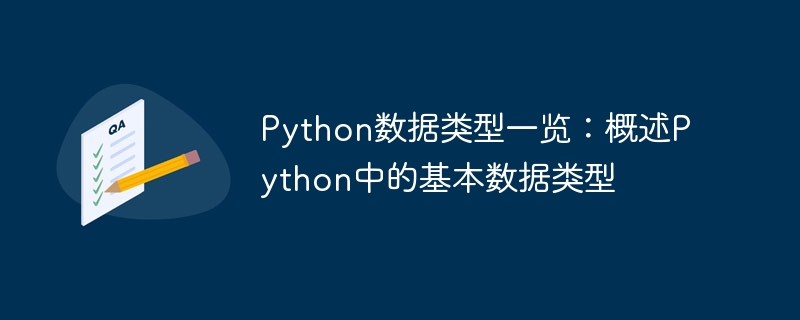
Python data types at a glance: Overview of the basic data types in Python, specific code examples required
Python is a concise, flexible and easy-to-learn programming language with a wide range of Used in various fields. In Python, there are various data types used to store and process data. This article will provide an overview of the basic data types in Python and provide code examples to help readers better understand.
- Integer (int) type:
Integer is one of the most commonly used data types in Python, used to represent numbers without decimal parts. For example, 1, 3, (-5) are all integers. We can define integer variables and perform basic arithmetic operations using the following code:
num1 = 5
num2 = 3
sum = num1 + num2
difference = num1 - num2
product = num1 * num2
quotient = num1 / num2
Copy after login
- Floating point (float) type:
Floating point numbers are used to represent numbers with decimal parts. For example, 1.5, 3.14, etc. are all floating point numbers. We can use the following code to define floating point variables and perform basic arithmetic operations:
num1 = 1.5
num2 = 3.0
sum = num1 + num2
difference = num1 - num2
product = num1 * num2
quotient = num1 / num2
Copy after login
- String (str) type:
String is used to represent text data and can contain letters , numbers and special characters, etc. In Python, strings can be enclosed in single or double quotes. For example, 'Hello' and "World" are both strings. We can use the following code to define string variables and perform basic operations:
str1 = 'Hello'
str2 = "World"
concatenation = str1 + str2
length = len(str1)
Copy after login
- List type:
List is an ordered variable data type that can Contains different types of elements. We can use the following code to define a list and perform basic operations:
list1 = [1, 2, 3, 'four', 'five']
length = len(list1)
element = list1[0]
list1.append(6)
list1.remove('four')Copy after login
- Tuple (tuple) type:
Tuple is an ordered immutable data type that can Contains different types of elements. Unlike lists, tuples cannot be modified once created. We can use the following code to define tuples and perform basic operations:
tuple1 = (1, 2, 3, 'four', 'five')
length = len(tuple1)
element = tuple1[0]
Copy after login
- Dictionary (dict) type:
A dictionary is an unordered, mutable data type consisting of keys Composed of value pairs. Each key-value pair consists of a key and a corresponding value, separated by a colon. We can use the following code to define a dictionary and perform basic operations:
dict1 = {'name': 'Alice', 'age': 25, 'gender': 'female'}
length = len(dict1)
value = dict1['name']
dict1['age'] = 26Copy after login
- Set type:
A set is an unordered mutable data type that can only contain The only element. We can use the following code to define a collection and perform basic operations:
set1 = {1, 2, 3, 4, 4, 'five'}
length = len(set1)
set1.add(5)
set1.remove(1)Copy after login
The above is an overview of the basic data types commonly used in Python and some sample codes for basic operations. By mastering these data types, we can process and manipulate data more flexibly. I hope this article will be helpful to readers in learning and using data types in Python.
The above is the detailed content of Overview of Python's basic data types: Understand the various data types in Python. For more information, please follow other related articles on the PHP Chinese website!






